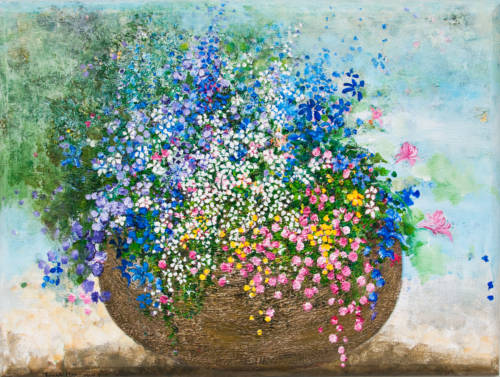Junghi Han’s “Voice of Nature” Explores The Human Condition Through Flowers
A few years ago, abstract artist Junghi Han became restless to try something new. After 14 years of working in the medium, she felt that abstract art was removed from the tactile world and longed to return to a recognizable form of painting. This inspired her latest exhibition, “Voice of Nature,” which recently shuttered its display in Chelsea’s Gallery d’Arte.
“Voice of Nature” is based off a poem called “From Dawn to Blossom” which begins: “One morning, after the passing of a harsh, relentless winter / I discover flowers blooming in the melting snow.” In a chaotic world, Han found that the transitions to the four seasons was a reliable constant. Her work is grounded in a return to the natural elements, an acknowledgment and appreciation for the concrete.
“Her work is grounded in a return to the natural elements, an acknowledgment and appreciation for the concrete.”
Han’s canvases are filled with flowers which often look like mini explosions. Her work startles the line between the real and the abstract. From a distance, the canvases look like realistic depictions of flowers in a vase, but up close they disintegrate, becoming dabs of colors and textures that blend seamlessly together.
Exploring the theme of flowers both within their natural environment and encapsulated within a vase is one of the oldest and methods of painting flowers. Drawing on this ancient motif, Han’s paintings maintain a classical composure, resembling Jan Brueghel the Elder’s bouquet from 1603, for example, even when they are grounded in an abstract method of painting. For Han, the vase becomes a metaphor as well, capturing the emotions the flowers expressed like two arms wrapped in an embrace.
The canvases contain a range of colors from somber dark blues to vibrant pinks and yellows. The accent colors are almost too bright, yet these artificial hues cast a playfulness into the paintings, contrasting and complimenting the darkness lurking in the background. For Han, the flowers become a microcosm of the human condition; painting them is about finding a balance between dark and light emotions, a way to express both the anger and depression of today’s world while conveying a philosophy of optimism and hope.
Han is also interested in transposing themes between the East and West. Originally from Korea, her husband is from Sweden, and she’s spent 39 years living abroad in Stockholm, Paris, and New York. Her work seeks to bridge differences between the cultures she’s been exposed to, bringing in techniques and styles from both. She does this in the manner by which she interplays painting techniques. The texture of the canvas, she explains, is influenced by the West, while the smooth strokes are an expression of calligraphy, which she draws on from her own (Eastern) culture. Yet, trying to combine her two worlds creates a tension, and the effort becomes complex and chaotic.
“Han paints flowers from memory rather than from observation, seeking to encapsulate multiple contrasts in her work: the dark and light; the East and West; and the consequent chaos that emerges when you mix them together.”
With a lifelong commitment to the study of art, Han received an M.A. in Seoul, Korea, where she studied Fine Art and Art History. She later studied at Permby’s Fine Art College in Sweden, and years later received an M.F.A. from the Long Island University. She’s exhibited her work in New York, Los Angeles, D.C., Paris, and Stockholm among many other international cities, and her work will be on view in Seoul this coming March.
Han paints flowers from memory rather than from observation, seeking to encapsulate multiple contrasts in her work; the dark and light, the East and West; and the consequent chaos that emerges when you mix them together. In some ways, this method is a response to the focus on the prevalent darkness, depression, and anger in our current society. At the heart of Han’s work, however, is an expression of optimism– a determination to birth beauty and be able to create a positive experience through its expression.




































